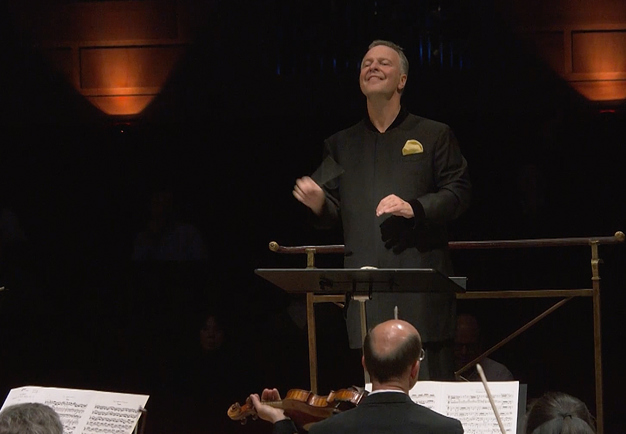Grande Finale – Sibelius with Oramo II
Sakari Oramo leads the Royal Stockholm Philharmonic Orchestra in Sibelius’ Symphonies No. 3 and 4 as well as the original and masterful Luonnotar, a piece that has become a true showpiece for the soprano Anu Komsi.
About the video
- From a livestream 22 May 2021.
- The video is approximately one hour and 38 minutes.
Grand Finale: Sakari Oramo’s final concerts as chief conductor of the Royal Stockholm Philharmonic Orchestra were an in-depth journey through Jean Sibelius’ creations, including all seven symphonies in chronological order. “In his case specifically, I believe the order matters”, said Sakari Oramo. “He worked on several symphonies simultaneously, and there are always elements in one symphony that can be detected in the symphony preceding it.”
After the first two national romantic symphonies, Symphony No. 3 bring something else entirely to the stage. It has been said that it is more classicist, in that the music seems to nod to older styles and tones. The third and final movement does, however, break free from simpler labelling, with its enigmatic blend of scherzo (jest) and hymn. The symphony was started in 1904, but the third movement was not finished until only a few days before the world premiere in 1907. Sibelius had now opened the door to something new.
In the years around 1910, a fourth symphony had occurred to him, but he also faced financial challenges and he was involved in other engagements. In spring 1911, after some delays, he was finished and he noted “Jacta alea est” in his diary – the die has been cast. This dramatic music is underscored by a recurring tritone – sometimes known as “the devil’s interval” – which infuses the music with internal anxiety and instability. The fourth and final movement is pure conflict between two notes on the tritone interval.
As usual, Sibelius worked on multiple pieces at once. Luonnotar – the creation myth in the first poem of the national epic, the Kalevala – recurred in different garb: it was intended as an orchestral poem at the time of Symphony No. 3; before then, in the form of Pohjola’s Daughter for orchestra (the title was originally Luonnotar); and even earlier, in an idea for an opera that never came to be. Luonnotar Op. 70 for soprano and orchestra was completed in 1913, after Symphony No. 4. Luonnotar (Nature’s Daughter) is a dizzying, evocative and breath-taking piece – with a rare, short composition time, during what seems to have been a flood of inspiration.
We will hear Finnish soprano Anu Komsi, whose precise and intense interpretation of Luonnotar has been universally acclaimed, and is something of a speciality.
-
The music
-
Jean Sibelius Symphony No. 3
-
Jean Sibelius Luonnotar for soprano and orchestra
-
Intermission: Conversation with Anu Komsi
-
Jean Sibelius Symphony No. 4
-
Participants
-
Royal Stockholm Philharmonic Orchestra
-
Sakari Oramo conductor
-
Anu Komsi soprano
Watch in our app
The Konserthuset Play app makes it easier to experience music on your phone or tablet – or on a big screen! Read more
FAQ about Konserthuset Play
Our tips for how to best take advantage of our selection and how you watch our livestreams. To FAQ
Do you want to make a donation to Konserthuset Play?
Make a swish payment to 123 493 99 89 or make your donation via our ticket system. Thank you!




